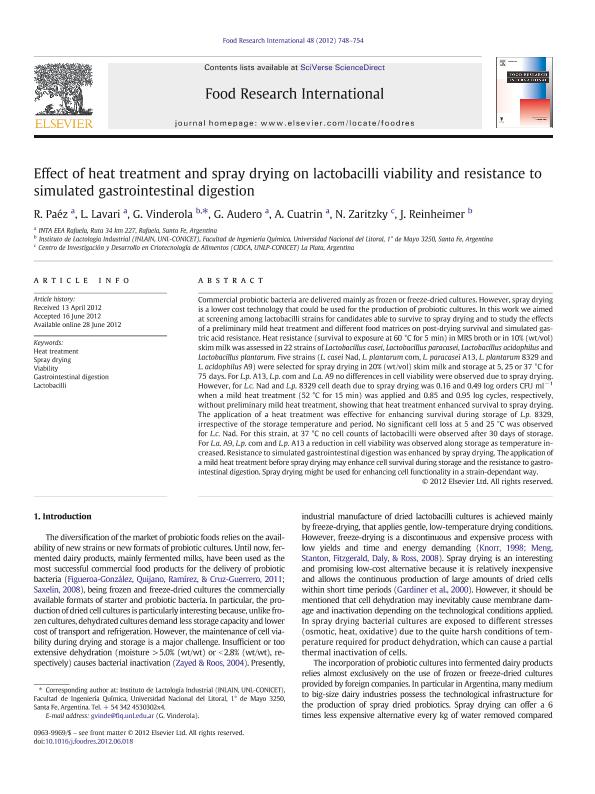Artículo
Effect of heat treatment and spray drying on lactobacilli viability and resistance to simulated gastrointestinal digestion
Paéz, R.; Lavari, Luisina ; Vinderola, Celso Gabriel
; Vinderola, Celso Gabriel ; Audero, G.; Cuatrin, A.; Zaritzky, Noemi Elisabet
; Audero, G.; Cuatrin, A.; Zaritzky, Noemi Elisabet ; Reinheimer, Jorge Alberto
; Reinheimer, Jorge Alberto
 ; Vinderola, Celso Gabriel
; Vinderola, Celso Gabriel ; Audero, G.; Cuatrin, A.; Zaritzky, Noemi Elisabet
; Audero, G.; Cuatrin, A.; Zaritzky, Noemi Elisabet ; Reinheimer, Jorge Alberto
; Reinheimer, Jorge Alberto
Fecha de publicación:
10/2012
Editorial:
Elsevier Science
Revista:
Food Research International
ISSN:
0963-9969
Idioma:
Inglés
Tipo de recurso:
Artículo publicado
Clasificación temática:
Resumen
Commercial probiotic bacteria are delivered mainly as frozen or freeze-dried cultures. However, spray drying is a lower cost technology that could be used for the production of probiotic cultures. In this work we aimed at screening among lactobacilli strains for candidates able to survive to spray drying and to study the effects of a preliminary mild heat treatment and different food matrices on post-drying survival and simulated gastric acid resistance. Heat resistance (survival to exposure at 60°C for 5min) in MRS broth or in 10% (wt/vol) skim milk was assessed in 22 strains of Lactobacillus casei, Lactobacillus paracasei, Lactobacillus acidophilus and Lactobacillus plantarum. Five strains (L. casei Nad, L. plantarum com, L. paracasei A13, L. plantarum 8329 and L. acidophilus A9) were selected for spray drying in 20% (wt/vol) skim milk and storage at 5, 25 or 37°C for 75days. For L.p. A13, L.p. com and L.a. A9 no differences in cell viability were observed due to spray drying. However, for L.c. Nad and L.p. 8329 cell death due to spray drying was 0.16 and 0.49 log orders CFUml -1 when a mild heat treatment (52°C for 15min) was applied and 0.85 and 0.95 log cycles, respectively, without preliminary mild heat treatment, showing that heat treatment enhanced survival to spray drying. The application of a heat treatment was effective for enhancing survival during storage of L.p. 8329, irrespective of the storage temperature and period. No significant cell loss at 5 and 25°C was observed for L.c. Nad. For this strain, at 37°C no cell counts of lactobacilli were observed after 30days of storage. For L.a. A9, L.p. com and L.p. A13 a reduction in cell viability was observed along storage as temperature increased. Resistance to simulated gastrointestinal digestion was enhanced by spray drying. The application of a mild heat treatment before spray drying may enhance cell survival during storage and the resistance to gastrointestinal digestion. Spray drying might be used for enhancing cell functionality in a strain-dependant way.
Archivos asociados
Licencia
Identificadores
Colecciones
Articulos(CCT - SANTA FE)
Articulos de CTRO.CIENTIFICO TECNOL.CONICET - SANTA FE
Articulos de CTRO.CIENTIFICO TECNOL.CONICET - SANTA FE
Articulos(CIDCA)
Articulos de CENTRO DE INV EN CRIOTECNOLOGIA DE ALIMENTOS (I)
Articulos de CENTRO DE INV EN CRIOTECNOLOGIA DE ALIMENTOS (I)
Articulos(INLAIN)
Articulos de INST.DE LACTOLOGIA INDUSTRIAL
Articulos de INST.DE LACTOLOGIA INDUSTRIAL
Citación
Paéz, R.; Lavari, Luisina; Vinderola, Celso Gabriel; Audero, G.; Cuatrin, A.; et al.; Effect of heat treatment and spray drying on lactobacilli viability and resistance to simulated gastrointestinal digestion; Elsevier Science; Food Research International; 48; 2; 10-2012; 748-754
Compartir
Altmétricas



